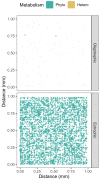Diffusional Interactions among Marine Phytoplankton and Bacterioplankton: Modelling H2O2 as a Case Study
- PMID: 35456871
- PMCID: PMC9030875
- DOI: 10.3390/microorganisms10040821
Diffusional Interactions among Marine Phytoplankton and Bacterioplankton: Modelling H2O2 as a Case Study
Abstract
Marine phytoplankton vary widely in size across taxa, and in cell suspension densities across habitats and growth states. Cell suspension density and total biovolume determine the bulk influence of a phytoplankton community upon its environment. Cell suspension density also determines the intercellular spacings separating phytoplankton cells from each other, or from co-occurring bacterioplankton. Intercellular spacing then determines the mean diffusion paths for exchanges of solutes among co-occurring cells. Marine phytoplankton and bacterioplankton both produce and scavenge reactive oxygen species (ROS), to maintain intracellular ROS homeostasis to support their cellular processes, while limiting damaging reactions. Among ROS, hydrogen peroxide (H2O2) has relatively low reactivity, long intracellular and extracellular lifetimes, and readily crosses cell membranes. Our objective was to quantify how cells can influence other cells via diffusional interactions, using H2O2 as a case study. To visualize and constrain potentials for cell-to-cell exchanges of H2O2, we simulated the decrease of [H2O2] outwards from representative phytoplankton taxa maintaining internal [H2O2] above representative seawater [H2O2]. [H2O2] gradients outwards from static cell surfaces were dominated by volumetric dilution, with only a negligible influence from decay. The simulated [H2O2] fell to background [H2O2] within ~3.1 µm from a Prochlorococcus cell surface, but extended outwards 90 µm from a diatom cell surface. More rapid decays of other, less stable ROS, would lower these threshold distances. Bacterioplankton lowered simulated local [H2O2] below background only out to 1.2 µm from the surface of a static cell, even though bacterioplankton collectively act to influence seawater ROS. These small diffusional spheres around cells mean that direct cell-to-cell exchange of H2O2 is unlikely in oligotrophic habits with widely spaced, small cells; moderate in eutrophic habits with shorter cell-to-cell spacing; but extensive within phytoplankton colonies.
Keywords: bacterioplankton; diffusional interactions; hydrogen peroxide; phytoplankton.
Conflict of interest statement
The authors declare no conflict of interest.
Figures






Similar articles
-
Genomic capacities for Reactive Oxygen Species metabolism across marine phytoplankton.PLoS One. 2023 Apr 25;18(4):e0284580. doi: 10.1371/journal.pone.0284580. eCollection 2023. PLoS One. 2023. PMID: 37098087 Free PMC article.
-
Rival phytoplankton contribute to the cross protection of Prochlorococcus from oxidative stress.Appl Environ Microbiol. 2025 May 21;91(5):e0112824. doi: 10.1128/aem.01128-24. Epub 2025 Apr 10. Appl Environ Microbiol. 2025. PMID: 40207967 Free PMC article.
-
Effect of hydrogen peroxide on natural phytoplankton and bacterioplankton in a drinking water reservoir: Mesocosm-scale study.Water Res. 2021 Jun 1;197:117069. doi: 10.1016/j.watres.2021.117069. Epub 2021 Mar 20. Water Res. 2021. PMID: 33784604
-
Production of extracellular reactive oxygen species by phytoplankton: past and future directions.J Plankton Res. 2018 Nov;40(6):655-666. doi: 10.1093/plankt/fby039. Epub 2018 Sep 26. J Plankton Res. 2018. PMID: 30487658 Free PMC article. Review.
-
Effects of solar UV-B radiation on aquatic ecosystems.Adv Space Res. 2000;26(12):2029-40. doi: 10.1016/s0273-1177(00)00170-8. Adv Space Res. 2000. PMID: 12038489 Review.
Cited by
-
Do carotenoids protect phytodetritus-associated bacteria from oxidative stress?Environ Sci Pollut Res Int. 2025 Apr;32(17):11167-11178. doi: 10.1007/s11356-025-36080-5. Epub 2025 Apr 8. Environ Sci Pollut Res Int. 2025. PMID: 40198437 Free PMC article.
-
Cellular Damage of Bacteria Attached to Senescent Phytoplankton Cells as a Result of the Transfer of Photochemically Produced Singlet Oxygen: A Review.Microorganisms. 2023 Jun 13;11(6):1565. doi: 10.3390/microorganisms11061565. Microorganisms. 2023. PMID: 37375067 Free PMC article. Review.
-
Prochlorococcus marinus responses to light and oxygen.PLoS One. 2024 Jul 22;19(7):e0307549. doi: 10.1371/journal.pone.0307549. eCollection 2024. PLoS One. 2024. PMID: 39038009 Free PMC article.
-
Phytoplankton-Bacteria Interactions 2.0.Microorganisms. 2023 Jun 9;11(6):1536. doi: 10.3390/microorganisms11061536. Microorganisms. 2023. PMID: 37375038 Free PMC article.
-
Genomic capacities for Reactive Oxygen Species metabolism across marine phytoplankton.PLoS One. 2023 Apr 25;18(4):e0284580. doi: 10.1371/journal.pone.0284580. eCollection 2023. PLoS One. 2023. PMID: 37098087 Free PMC article.
References
-
- Reynolds C.S. The Ecology of Phytoplankton. Cambridge University Press; Cambridge, UK: 2006.
-
- Purcell E.M. Life at Low Reynolds Number. Am. J. Phys. 1976;45:3–11. doi: 10.1119/1.10903. - DOI
-
- Finkel Z.V., Beardall J., Flynn K.J., Quigg A., Rees T.A.V., Raven J.A. Phytoplankton in a Changing World: Cell Size and Elemental Stoichiometry. J. Plankton Res. 2010;32:119–137. doi: 10.1093/plankt/fbp098. - DOI
Grants and funding
LinkOut - more resources
Full Text Sources

